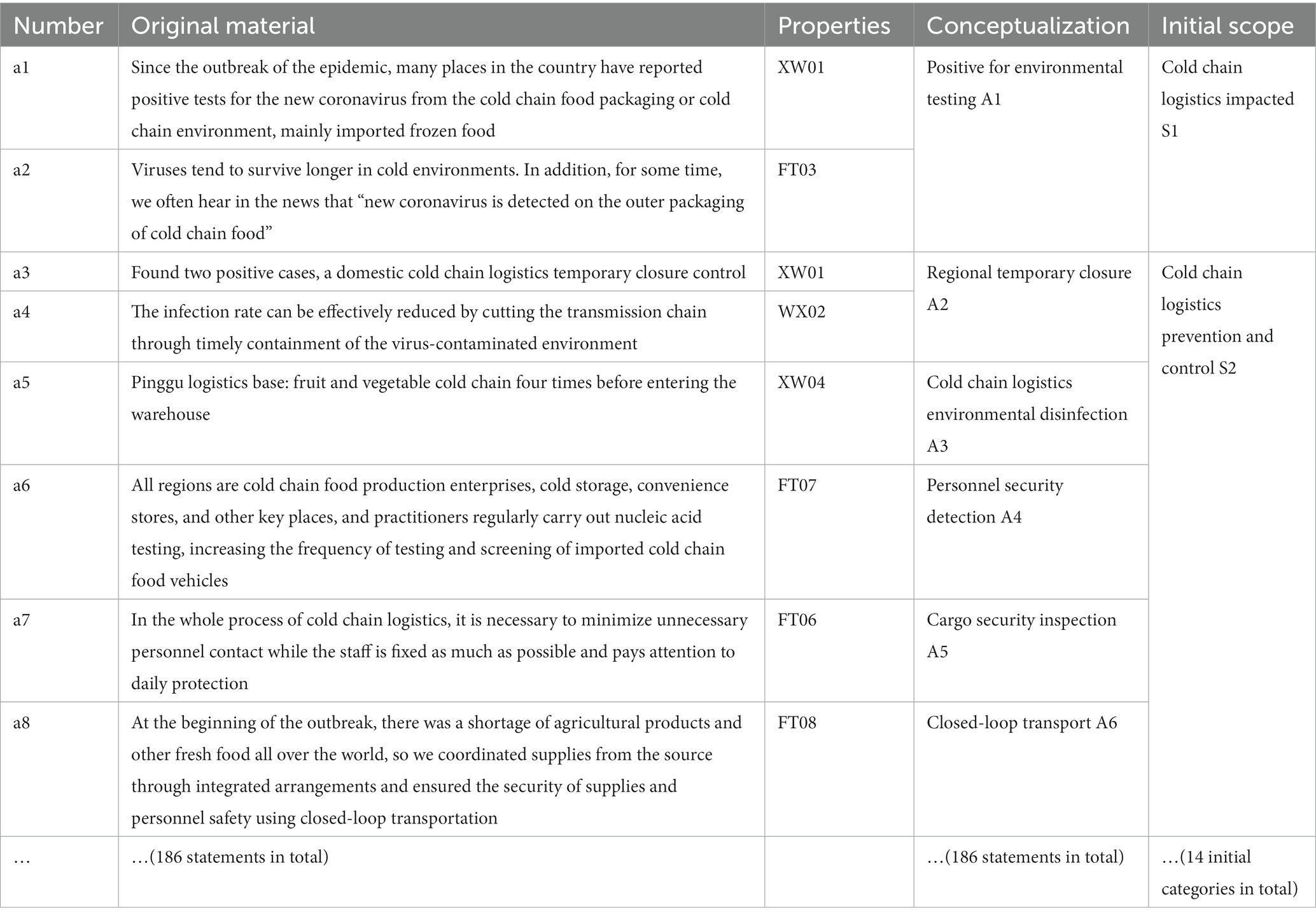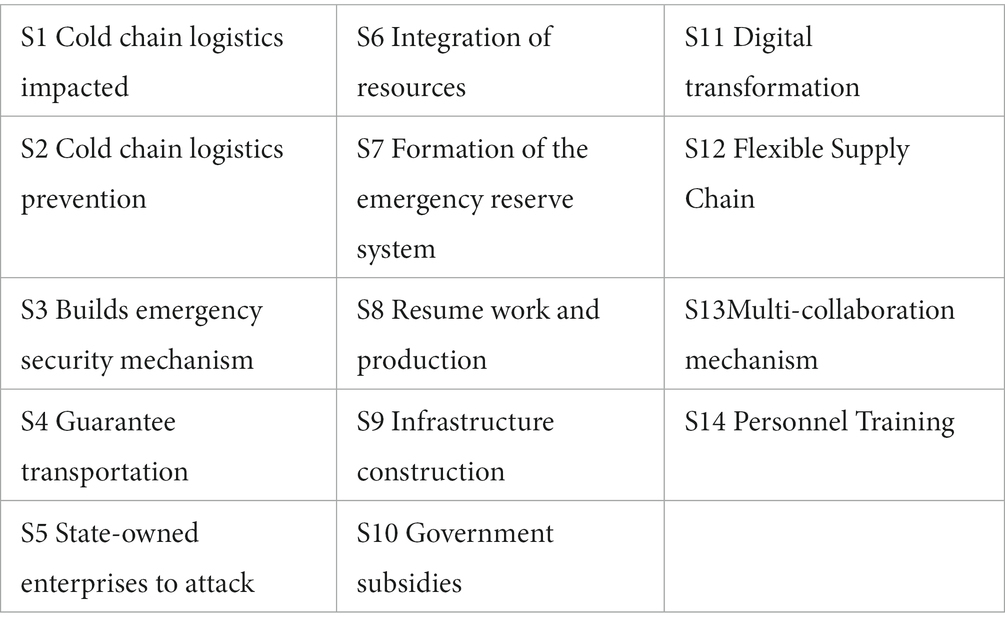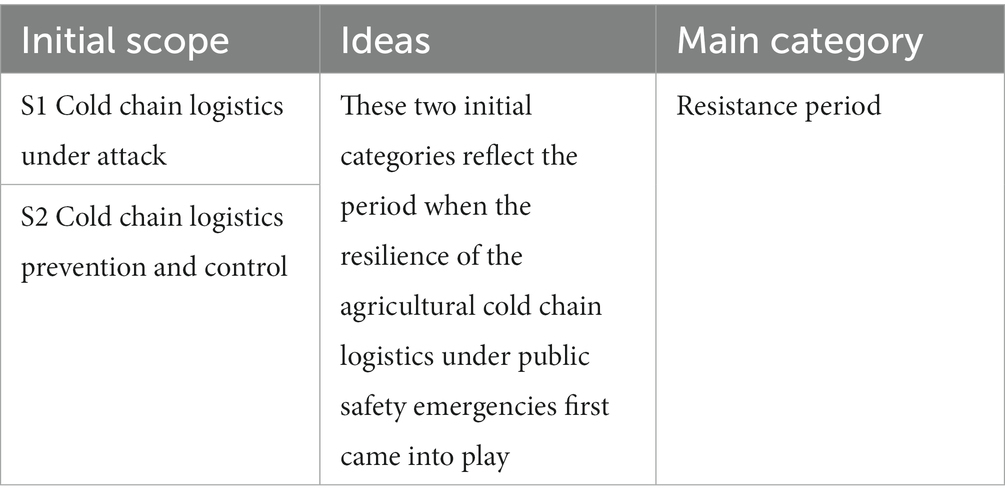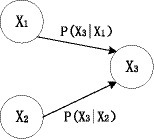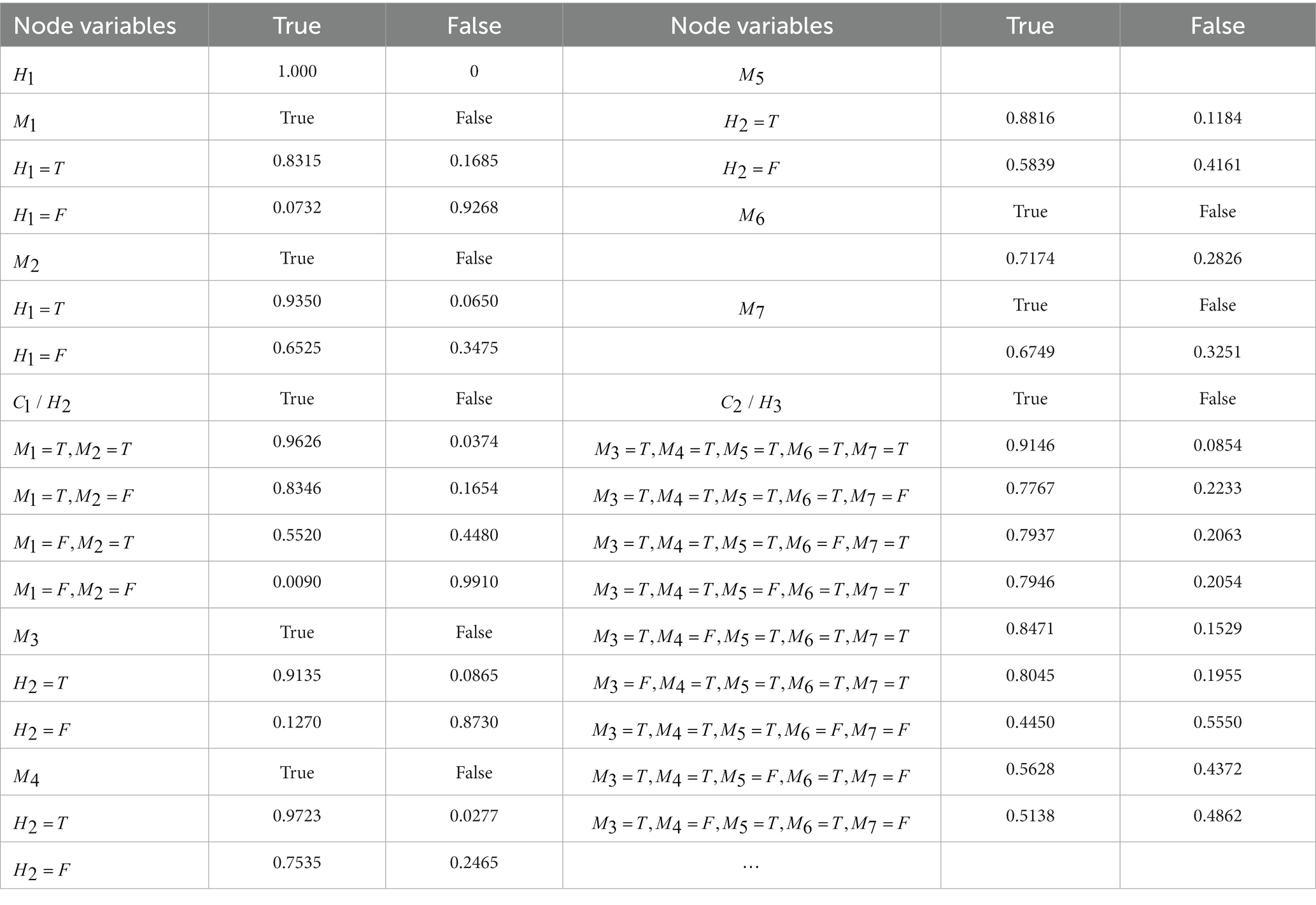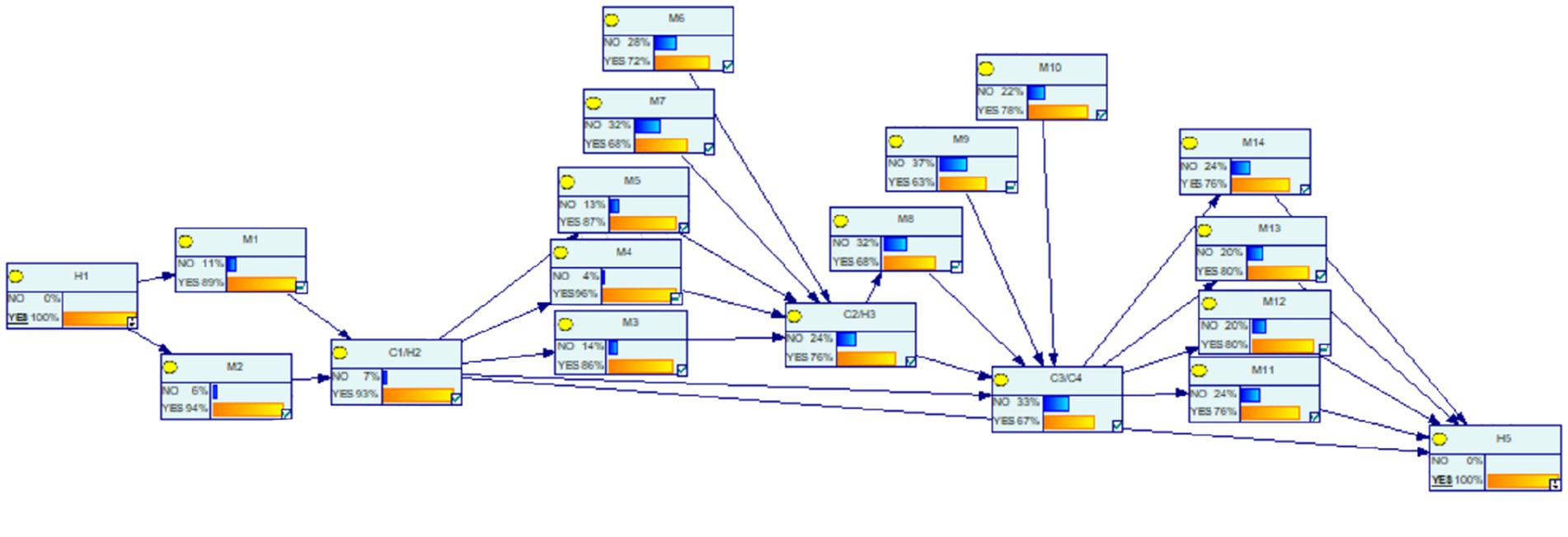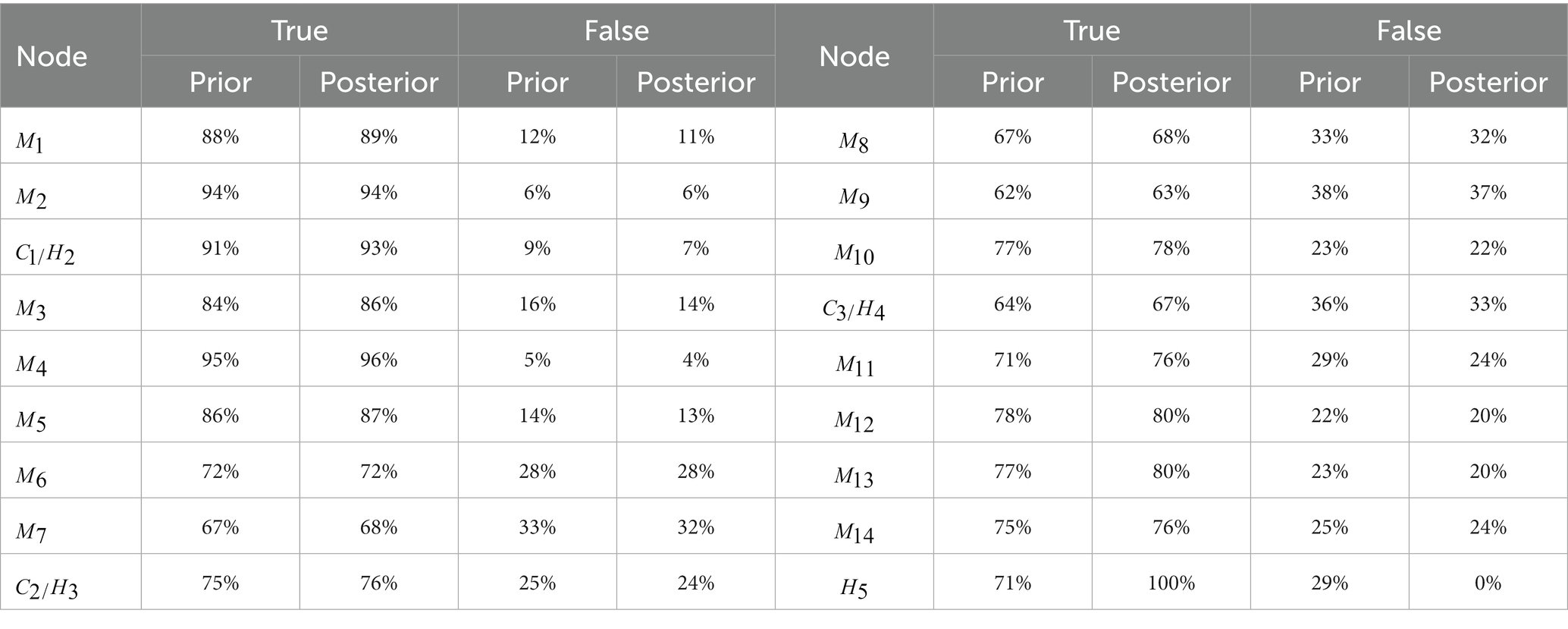- Wuhan University of Technology, School of management, Wuhan, China
Under a sudden public security event, as agricultural cold chain logistics has the characteristics of many participating subjects and wide spatial and temporal distribution, it is extremely vulnerable to shocks. Even minor disruptions in logistics can result in a significant impact on the daily lives of residents. Therefore, improving the resilience of agricultural cold-chain logistics is crucial for sustainable development. This paper studies the sustainable development path of agricultural cold chain logistics from a resilience perspective. Through rooting theory, the process of resilience in agricultural cold chain logistics under sudden public safety events is explored. Based on the knowledge meta-model, three elements of resilience events, resilient subjects, and resilience measures are used to contextualize the resilience process, and finally, using Bayesian networks and fuzzy set theory, a contextual derivation model of the resilience process of agricultural cold chain logistics under sudden public safety events is created. The results show that the resilience process of sustainable development consists of a resistance period, an adaptation period, a readjustment period, and an innovation period, during which the government and enterprises jointly take measures to effectively resist the impact of public emergencies, and further enhance the resilience through innovative development to ensure the sustainable development of agricultural cold chain logistics.
1. Introduction
In recent years, with the continuous development of China’s economy and society, people’s living standards have been improving, consumers’ demand for fresh agricultural products has been rising, and the National Development and Reform Commission and other 12 departments have issued implementation opinions on further optimizing the development environment to promote the circulation of fresh agricultural products (Zengjun, 2022), the coupling and coordination degree of cold chain logistics and economic development is steadily increasing (Xie et al., 2022). Cold chain logistics involves multiple subjects and links, and there are many service providers, which easily leads to cold chain breakage, restricting the expansion of the scale of agricultural cold chain operation. Cold chain logistics must enhance the market operation ability of the operators through sustainable development, further improve the standardization system of the cold chain industry, and continuously improve the level of standardized services (Luo et al., 2021). In recent years, sudden public security events have occurred frequently, and it is necessary to improve the resilience of agricultural cold chain logistics under sudden public security events and avoid the risk of interruption (Xing et al., 2020). In addition, to achieve the sustainable development of fresh agricultural products cold chain logistics, it is also necessary to clarify the causes of cold chain logistics breakage, and put forward corresponding countermeasures and suggestions to enhance the resilience of cold chain logistics (Zhang and Huo, 2021). Given the problem of evaluating the emergency logistics capacity of agricultural products under disaster conditions, some scholars adopt a combination of qualitative and quantitative research methods based on analyzing the factors affecting the emergency logistics capacity of far products under natural disasters, the evaluation index system of emergency logistics capacity of agricultural products under natural disaster conditions is constructed to evaluate the emergency logistics capacity of agricultural products to provide a technical basis for improving the emergency logistics capacity of agricultural products under natural disaster conditions (Zou et al., 2013). The risk assessment index system can also scientifically reflect the critical risk factors of agricultural product cold chain logistics. The disaster progress assessment method proposed by the key risk factors can predict the risk scientifically and reasonably (Zhang et al., 2017).
Resilience is considered one of the critical characteristics of current supply chain systems to cope with the uncertainty caused by the latest environmental, economic, and social crises. Especially in the agri-food supply chain, there is an urgent need to build a more resilient and adaptive agri-food supply chain system. The research on the resilience of agricultural cold chain logistics could be better. Some scholars have only studied the critical success factors of building a resilient agri-food supply chain (Kontopanou et al., 2021). Given the problem that the theoretical system is not sound in the research of agricultural product logistics, some scholars use the rooted theory to build a theoretical system rooted in accurate data and phenomena (Shu and Hu, 2020), which provides ideas for the research on the resilience of agricultural product cold chain logistics. Resilience is the ability of things to return to their initial state, which can be divided into engineering resilience, ecological resilience, and evolutionary resilience (Holling, 1973; Pimmsmm, 1984; Ramlogan and Metcalfe, 2006). As an economic activity, the resilience of cold chain logistics of agricultural products is evolutionary (Martin et al., 2016). Many resilience elements in evolutionary resilience can be used to enhance resilience. However, their selection and implementation must be carefully matched to the relevant stages of disruption and assessed against their broader supply chain impact. Research must focus on the overall impact on the supply chain (Stone and Rahimifard, 2018). Combined with the characteristics of many participants and complex systems in the cold chain of agricultural products (Mingfei and Xin, 2018), some scholars draw on the reliability analysis ideas in reliability engineering theory and concretize the abstract problem of cold chain logistics system failure according to the operation characteristics of the cold chain logistics system and the causal relationship between events, and construct its fault tree. Bayesian networks are generated based on fault trees to estimate the operational reliability of cold chain logistics systems and reveal the leading causes of system failures (Guo et al., 2015). The resilience evolution process is regarded as an uncertain event, and Bayesian networks are used to deduce (Qiu et al., 2011). Bayesian network modeling and simulation are used to identify and perform sensitivity analysis on major influencing factors to analyze the entire cold chain logistics system and risk events (Zheng et al., 2021). Based on Bayesian theory, some scholars have constructed a topology of the risk of interrupting new cold chain networks. Fuzzy set theory is used to predict and calculate the probability of each root node to determine essential risk factors. Strategies to reduce the risk of broken chains were explored (Chen et al., 2021).
Currently, the majority of studies on agricultural cold chain logistics center around risk and efficiency (Yuan et al., 2020; Lin, 2021), but most scholars study the resilience of agricultural cold chain logistics from a static perspective (Huang et al., 2020; Wenping and Yuwan, 2022; Xu and Tang, 2022). There is a significant gap in the dynamic research on the resilience development of agricultural cold chain logistics. Previous studies have mostly employed Bayesian networks (Zhang et al., 2017) and system dynamics (Xu et al., 2021) to analyze the risk and efficiency of cold chain logistics. While the scope of these studies differs from that of the present paper, they do provide a theoretical framework for analyzing contextual evolution and uncertainty. This paper addresses the problem that the process of resilience of agricultural cold chain logistics is not clear, combines previous research results, collects relevant information, constructs the process of resilience of agricultural cold chain logistics under unexpected public events by using the rooting theory, contextualizes the process by using the knowledge meta-theory, and finally constructs a dynamic evolutionary inference model by using Bayesian networks. Considering the subjectivity problem in the process of Bayesian network construction, this paper processes the evaluation of experts and scholars through fuzzy set theory to obtain the conditional probability of Bayesian network. The study visualizes the process of the role of resilience, and provides reference for government enterprises to enhance the resilience of agricultural cold chain logistics and resist the impact of unexpected public events.
2. Exploring the process of the resilience of agricultural cold chain logistics under sudden public safety events
2.1. Research methodology
Rooting theory intervenes in the environment of the problem under study through participant observation and interviews to obtain primary data. It constructs a theoretical system rooted in accurate data and phenomena from the bottom up through the graded induction and refinement of the primary materials (Shu and Hu, 2020). Jia (2016) made moderate methodological innovations and refinements to the rooting theory, organically integrated qualitative and quantitative research methods, and proposed the basic model of the Chinese management rooting research paradigm. Most of the current research on agricultural cold chain logistics focuses on exploring the efficiency and vulnerability of agricultural cold chain logistics from a static perspective. Less research analyzes the dynamic evolution mechanism of the toughness of agricultural cold chain logistics from a dynamic evolutionary perspective, and most of them draw on the previous research results and the mechanism of the role of the toughness of agricultural cold chain logistics under the sudden public safety events in China is not thoroughly studied. Therefore, this paper uses the constructive rooting theory to study the evolutionary process of the toughness of agricultural cold chain logistics under sudden publicity time to explore its resilience mechanism further.
2.2. Research methodology
To ensure the reliability and systematicity of the data, this study explores the evolutionary process of the toughness of agricultural cold chain logistics through expert interviews, literature, policies and regulations, and news material analysis in October 2022. In terms of expert interviews, considering that cold chain logistics is a complex system project with a potent combination of practical and theoretical characteristics, the interviewees of this paper were selected as experts and scholars in the field of logistics, executives of logistics enterprises, and cold chain logistics staff, etc. Fifteen interviews were obtained through semi-structured interviews. In terms of literature collection, the keywords “cold chain logistics,” “cold chain logistics resilience,” “logistics resilience,” “public safety emergencies” etc. were used in the research of domestic and international databases. The keywords “cold chain logistics,” “cold chain logistics resilience,” “logistics resilience,” “sudden public safety events” etc., were searched in domestic and international databases for relevant literature from January 2020 to October 2022, from which 65 Chinese and English literature were selected. In terms of policies and regulations, relevant policies and regulations were collected from the official websites of the State Council, Ministry of Commerce, Ministry of Transportation, local governments, and relevant functional departments with keywords such as “cold chain logistics” and “agricultural product.” At the level of news materials, we collected relevant news reports from January 2020 to the present on the websites of People’s Daily Online, Xinhua Online, China Agriculture Network, China Logistics and Purchasing Network, etc. After comparing and deweighting, we finally collected 30 relevant materials. Two randomly selected from each expert interview, literature, policy, regulations, and news materials were tested for saturation.
2.3. Open codes
The collected textual information was decomposed paragraph by paragraph and sentence by sentence, and the contents related to the resilience of cold agricultural chain logistics were selected and conceptualized. The concepts were categorized and analyzed to derive the categories, and finally 89 concepts and 14 categories were extracted. The open coding is shown in Table 1, and the categories obtained from the open coding categorization process are shown in Table 2.
2.4. Spindle type code
The initial concepts and categories obtained from the previous coding analysis were summarized, and the laws were refined and summarized more deeply. In this study, 14 initial categories are obtained through inductive analysis, such as cold chain logistics epidemic, cold chain logistics epidemic prevention and control, emergency assurance logistics, guaranteeing transportation, state-owned enterprises taking charge, coordinating logistics resources, and forming an emergency reserve system.
This study considers that the cold chain logistics resilience of agricultural products is the economic toughness of the industry studied from the meso level. Among the existing studies, a more accurate and accepted definition of economic resilience comes from study of Martin et al. (2016). This study argues that economic resilience to recessionary shocks should include four aspects, namely, resistance (the degree of sensitivity and response of the economy to recessionary shocks), resilience (the speed and degree of economic recovery from recessionary shocks), readjustment capacity (the ability of regional economies to restructure in the face of recessionary shocks), and the ability to create economic growth paths (the ability of the economy to open new stable growth paths) after suffering shocks (the ability of the economy to open a new stable growth path after a shock). The process of resilience in cold chain logistics evolves gradually over time. Therefore, this paper will study the resilience process of cold chain logistics from the perspective of evolutionary resilience and further summarize the initial categories based on evolutionary resilience theory, as shown in Table 3.
According to the process of the action of resilience, the 14 initial categories were grouped into four aspects in the formation of the master categories: resistance period, recovery period, readjustment period, and innovation period, as shown in Table 4.
2.5. Selective coding
Selective coding is the process of selecting the core category, systematically linking it to other categories, verifying the relationships between them, and completing the conceptualization of those categories that are not fully developed. Through inductive abstraction during the resistance period, recovery period, readjustment period, and path creation period, the core category was finally identified as “the process of resilience of agricultural cold chain logistics under public safety emergencies,” and a theoretical model of the process of resilience of agricultural cold chain logistics under public safety emergencies was constructed, as shown in Figure 1.
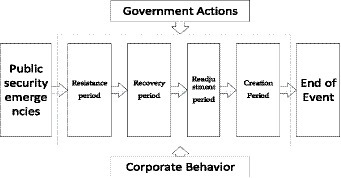
Figure 1. The process model of the resilience of agricultural cold chain logistics under emergency events.
2.6. Saturation test
The eight selected text materials were tested for theoretical saturation to determine the comprehensiveness of the theoretical model constructed using the zapping method. Concepts and categories were extracted from the eight texts according to the three-level coding of the rooting method, and the analysis results were compared with the previously constructed “the process of the resilience of agricultural cold chain logistics in the context of public security emergencies” and no new concepts and categories were found. The results do not reveal any new concepts and categories, which indicate that the categories defined in this study can effectively reflect the process of the resilience of agricultural cold chain logistics in the context of public safety events.
3. Situational representation based on knowledge metatheory
3.1. Knowledge metatheory
Knowledgeable element is the basic knowledge unit that can effectively, independently, and freely identify, process, and combine knowledge of knowledge management (Wen, 2007). The knowledge of the resilience action process of agricultural cold chain logistics under sudden public security events is composed of each independent knowledge element related to agricultural cold chain logistics by the mechanism of resilience action. Using the standard knowledge model to express the resilience action process, the standard knowledge model can be expressed as follows:
Equation (1) expresses the tenacity process consisting of multiple entity variables. Where denotes an attribute, denotes an attribute, and denotes an inter-attribute relationship.
If an attribute a ∈ A, the attribute knowledge metamodel is used to describe its attribute state as follows:
In which is the feature of the object attribute, is the magnitude of the attribute, and denotes the time-varying function of the attribute state. Finally, the relational knowledge meta-model is used to describe object knowledge meta-attributes specifically see the relation:
Where is the relational attribute, is the set of input and output attribute states, and is the mapping function.
3.2. Knowledge meta-representation of scenarios
According to the results of the previous research on the process of resilience action of agricultural cold chain logistics under unexpected public safety events using the rooting theory, the knowledge meta-model is used to deeply explore the action process, interconnection, and developmental evolution mechanism of the resilience of agricultural cold chain logistics, identify the key factors affecting the action of resilience, and make scenario representation of the action process of resilience to lay the foundation for the construction of Bayesian network. In this paper, referring to the research results of scholars on evolutionary resilience and drawing on the classification method of Zhang on unexpected events (Zhang et al., 2013), the scenario of the resilience action process is divided into three knowledge bodies: resilience event ( ), resilience measure ( ), and resilience subject ( ), as shown in Figure 2.

Figure 2. Knowledge of agricultural cold chain logistics resilience under sudden public safety events.
Combined with the above study, a phased scenario description of the resilience process of agricultural cold chain logistics under public safety emergencies is shown in Table 5.
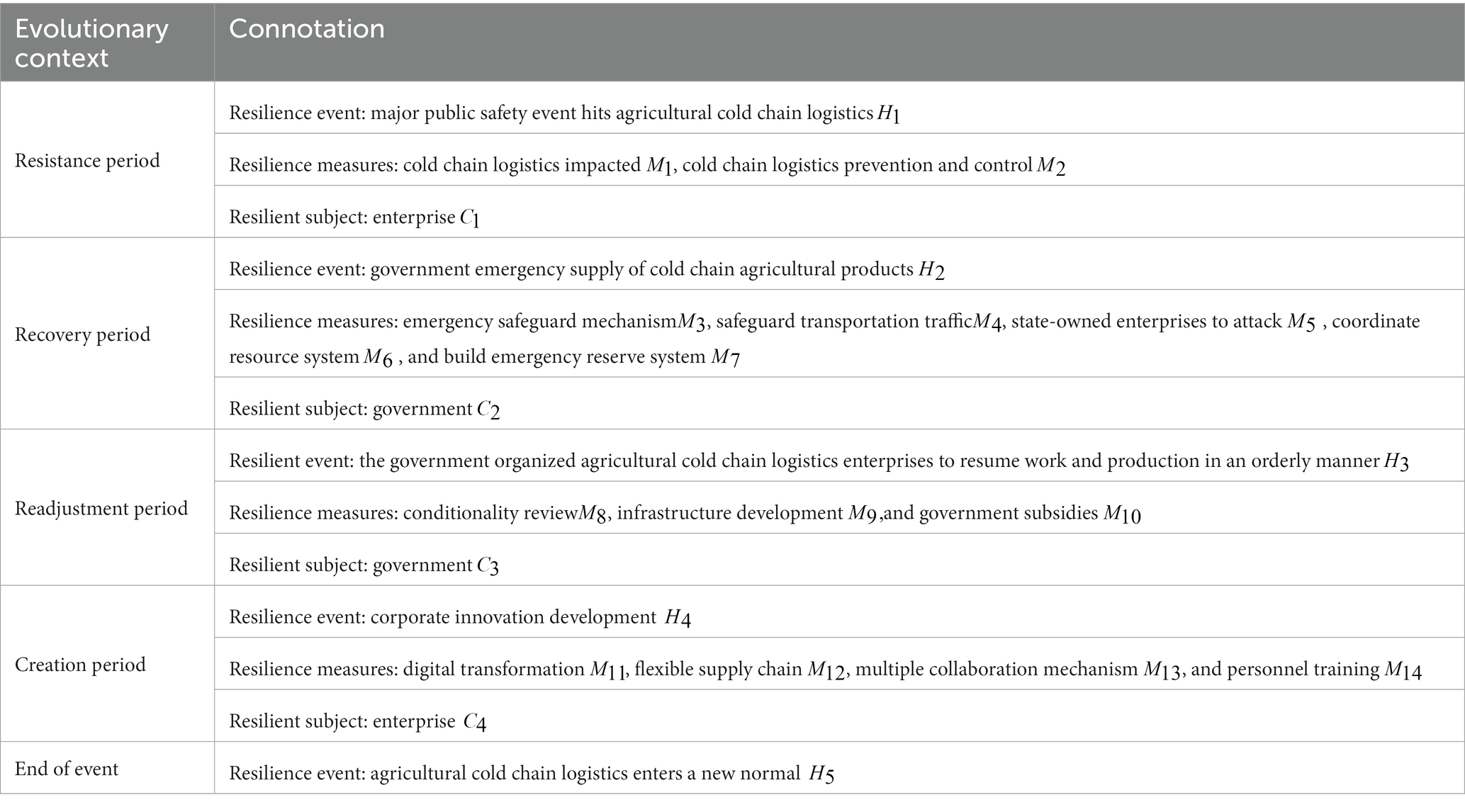
Table 5. Knowledge meta-expression of the resilience role of agricultural cold chain logistics under sudden public safety events.
4. Bayesian network construction and inference for resilient action processes
The sustainable development of agricultural cold chain logistics under a sudden public safety event is a process in which the resilience elements in each scenario interact and work together. The scenario projection of the resilience process is a process of analyzing the relationship between the various elements in the context of the current scenario development status to obtain the input elements for the next scenario. In situations where governments and enterprises are responding to public safety emergencies, it is difficult for decision-makers to accurately grasp the development situation or the resilience process due to many reasons, such as the untimely receipt of information and unreliable sources. In the case of public safety emergencies, it is clear that the resilience projection of agricultural cold chain logistics is carried out under conditions of incomplete knowledge or uncertainty of information, and the information available is generally qualitative in the description. This makes it impossible to rely on formulaic models for mathematical reasoning about agricultural cold chain logistics resilience under public safety emergencies. The construction of a Bayesian network requires the determination of the nodal variables and the interrelationships between the nodal variables of the resilience action process, i.e., conditional and prior probabilities. Whether the probabilities of the nodal variables are assigned scientifically and rationally is directly related to the accuracy of the inferred results. Research shows that in an uncertain environment, based on fuzzy set theory, the method of transforming the event probabilities described by fuzzy language into triangular fuzzy numbers or trapezoidal fuzzy numbers to finally obtain comprehensive evaluation results is practical and feasible (Chaoguang et al., 2003). The cold chain logistics resilience action scenario is used as an abstract expression and the adoption of this theoretical approach applies to the practical situation of Bayesian network derivation.
This paper extracts the key knowledge elements of the resilience process and represents them as nodal variables in a Bayesian network. The nodal variables that have a causal relationship with the development stage of resilience are connected to form the resilience scenario network of agricultural cold chain logistics under sudden public security events. GeNle software is utilized to calculate the state probability of the corresponding nodal variables and derive the resilience process of agricultural cold chain logistics under sudden public security events. By projecting the action process of the resilience of agricultural cold chain logistics under sudden public safety events, the network is designed to explore the nodes and mechanisms of each measure from a global perspective, effectively addressing the problems of information asymmetry among decision-makers and an inaccurate understanding of the resilience development stage.
4.1. Bayesian network
Bayesian network (Bayesian Network) is a probabilistic graphical model describing the dependencies between variables, which can make inference from incomplete and uncertain knowledge, and is one of the most compelling ethical models in the field of uncertain knowledge representation and inference. As shown in Figure 3, the Bayesian network is a Directed Acyclic Graph (DAG), which consists of nodes and directed edges. Each node represents a random variable of an event, and the directed edges represent the interrelationships among the node variables, respectively. P represents the probability of occurring under the condition that scenario occurs, and the node variables without parent nodes can be expressed as prior probabilities.
Given a joint conditional probability distribution P ( ) and an ordering of variables. At level I from the set of parent nodes, a set of directional lines are drawn linking to and represented quantitatively by the P conditional probabilities, resulting in a directed acyclic graph that can be used to represent many independent relationships embodied in P( ), which is called a Bayesian network. The P contains all the information necessary to reconstruct the original distribution function, in the specified order, constitutes the joint probability distribution of all nodes in the Bayesian network:
4.2. Bayesian network construction
According to the above, the construction of Bayesian network needs to determine the node-year amount of resilience action and the relationship between each node, i.e., the joint probability distribution of the Bayesian network is constructed by obtaining the prior probability and conditional probability. This paper contextualizes the process of resilience action by applying rooted theory and knowledge meta-model, which is divided into four scenarios (resistance period, recovery period, readjustment period, and path creation period). Each scenario consists of three components [resilience event ( ), resilience measure ( ), and resilience subject ( )], and the interaction among the component factors drives the scenario development. The relationship between the nodal variables is explored through data collection and analysis and expert scoring. A Bayesian network is constructed based on the knowledge meta-model of the resilience of agricultural cold chain logistics under unexpected public safety events, as shown in Figure 4.
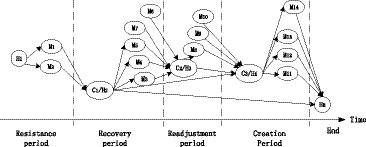
Figure 4. Bayesian network of resilient action process of agricultural cold chain logistics under sudden public safety events.
4.3. Bayesian network construction
The scientific validity of the Bayesian network inference results directly depends on the accuracy of the probabilities of the nodal variables. While the prior probabilities in the text can be determined by collecting historical data, the conditional probabilities cannot be obtained precisely due to problems in data collection. Therefore, usually, the selection of conditional probabilities requires inviting experts from all walks of life to make descriptive evaluations of the relationships among nodal variables using abstract terms based on their own experiences, and cannot directly give accurate quantitative evaluations.
In this paper, 10 experts and scholars are invited to pay the conditional probability of each nodal variable by qualitative descriptive evaluation based on their own experience and expertise, and the expert evaluation is processed by using fuzzy set and DS (Dempster-Shafer) theory to find out the clear probability value of each variable. It has been shown that the probabilistic speculation accuracy of Bayesian networks modified by DS evidence theory is around 90%, which indicates the scientific nature of using this method to guide decision subjects to take relevant measures (Zou and Yue, 2020).
To improve the accuracy of Bayesian network probability values, we first apply fuzzy set theory to transform qualitative evaluations into fuzzy numbers and represent fuzzy probabilities as fuzzy subsets. Next, we apply DS theory to fuse each expert’s fuzzy probabilities and reduce cognitive uncertainty resulting from subjective factors. We use triangular and trapezoidal fuzzy numbers to represent seven qualitative evaluation variables: very high, high, high, medium, low, low, and very low, and obtain clear probability values using the integrated value method, as shown in the following equation:
Where is the arithmetic mean of the evaluation results of each expert, is the integral values of the inverse functions of the affiliation functions around the fuzzy numbers, λ is the threshold value, the set consisting of elements with affiliation greater than λ is the λ-level intercept set of the fuzzy set, and denote the upper and lower bounds of the fuzzy probability of the node variable , respectively.
The formula α∈ (0, 1), when α = 0.5, is the representative value of solution fuzzy value.
In this paper, 10 experts and scholars are invited to pay the conditional probability of each node variable according to their own experience and expertise by qualitative description evaluation, and the expert evaluation is processed by using fuzzy set theory to find out the exact probability value of each variable. Assume that the independent trust functions are and , the mess functions are and , and the focal elements of the trust functions A and B are: …; , , … . The DS-theoretical fusion equation is:
If there are three independent states A, B, and C in a Bayesian network of the resilience of agricultural cold chain logisticsunder unexpected public safety events, the fuzzy probabilities empirically derived by experts are assigned to the three independent states: Bringing the above experts’ assignments into the formula respectively, the fusion probability values of the three states can be found, as shown in Table 6.
4.4. Bayesian network deduction
Using the Bayesian network and conditional probability table constructed above, the software GeNle is used to deduce and obtain the probability of each node variable in the case of forward and reverse deduction, as shown in Figures 5, 6. The probability of each node variable is summarized and compared, as shown in Table 7.
4.5. Deduction results
According to the analysis of the deduction results of the Bayesian network, it is found that the situation of the resilience process of agricultural products cold chain logistics under major public security incidents is from the government’s emergency supply of cold chain agricultural products, the government’s organization of orderly resumption of production of agricultural products cold chain logistics enterprises, the innovation and development of enterprises and the cold chain logistics of agricultural products into the new normal, with the probability of 91, 75, 64, and 71%, respectively. The results show that the government’s emergency supply of cold chain agricultural products is very likely to have occurred, and the government’s organization of orderly resumption of production of agricultural products cold chain logistics enterprises, the innovation and development of enterprises and the cold chain logistics of agricultural products into the new normal are developing steadily. It shows that the deduction process is highly consistent with the actual situation in China. According to the specific situation deduction results, the probability of the government’s emergency supply of cold chain agricultural products is 91%, indicating that the sudden public security incidents have caused a more significant impact on the cold chain logistics of agricultural products. The government must intervene and guide the industry to effectively deal with the impact and maintain the stable operation of the logistics. In terms of the orderly resumption of work and production of cold chain logistics enterprises of agricultural products organized by the government, due to the problematic epidemic situation abroad, China is facing the dual pressure of “external defense input, internal defense rebound,” so the resumption of work and production of cold chain logistics enterprises is still facing intermittent pressure; in the face of enterprise innovation and development, due to the particularity of the industry, agricultural products cold chain logistics enterprises suffered a considerable impact, enterprises are facing pressure to survive. At the same time, the impact of sudden public safety incidents has not entirely disappeared. The current primary goal of enterprises is stability rather than innovation. Most enterprises choose to maintain the adjusted operation mode. On the other hand, some enterprises are also actively exploring new technologies and operating models to enhance their resilience to sudden public safety incidents after adaptation and adjustment. Therefore, the inference results of the Bayesian network in this paper align with the reality of enterprise development.
Through the analysis of the results of the resilience measures, it can be found that the government tends to adopt the way of ensuring transportation (95%), emergency guarantee mechanism (84%), and state-owned enterprises (86%) to supply cold chain agricultural products urgently. The government prefers the method of government subsidy (77%) in organizing enterprises to resume production. There are still deficiencies in long-term mechanisms such as “building an emergency reserve system (67%)” and “infrastructure construction (62%).” At the level of enterprise measures, enterprises are more inclined to adopt low-input methods such as “flexible supply chain,” “multi-collaboration mechanism,” and “personnel training” to improve their resilience to public safety emergencies. Due to the uncertainty and economic loss caused by sudden public safety incidents, enterprises adopt conservative innovation strategies such as optimizing stock resources. However, by comparing the prior and posterior probabilities of events, the difference between the two is the largest in enterprise digitization, which indicates that enterprises should properly carry out digital transformation, which is more conducive to improving enterprise resilience.
5. Discussion
This paper first uses the grounding theory to construct the resilience process of cold chain logistics of agricultural products under public safety emergencies and clarifies the research object and scope. Then, the knowledge element model is used to contextualize the resilience process. The Bayesian network and fuzzy set theory are used to construct a contextual deduction model of agricultural product cold chain logistics resilience under public safety emergencies. This study finds that the sustainable development of agricultural cold chain logistics under major public safety events requires not only seeking and relying on multifaceted collaboration between the government and enterprises at all stages and in all aspects but also establishing a timely feedback mechanism to solve the problems in the collaboration and ultimately achieve sustainable development. Research contributions are as follows:
Firstly, this paper summarizes the cold chain logistics management of agricultural products from the perspective of “resilience” and verifies that under the emergency public safety incident, digital transformation, flexible supply chain, diversified collaboration, and other measures are effective methods for the cold chain logistics management of agricultural products. In the existing literature, Huang et al. (2020) studied the real-time emergency management mode of agricultural product cold chain logistics under the background of “Internet +” and concluded that through the information upgrade of cold chain logistics, the circulation loss between nodes could be reduced. The emergency management circulation efficiency of the supply chain can be improved. Wei and Lv (2019) applies the Internet of Things to the cold chain logistics of agricultural products and establishes an IoT-based logistics distribution system for agricultural products. Complete the real-time supervision of the whole process of agricultural product distribution, strengthen the information communication of each distribution link, and improve the efficiency of agricultural product distribution. However, the conclusions of this paper differ from those of Yan et al. (2021), who argue that technological inefficiencies and facility costs are the most severe risks affecting food loss and waste. This may be because, in recent years, due to the impact of sudden public safety incidents, the development of the industry has been affected by many uncertainties in the short term, and the return on equipment investment is unstable. The use of technology has been affected, and the adoption of digital transformation, flexible supply chain, and other measures can effectively reduce the vulnerability and improve the resilience of agricultural products’ cold chain logistics under sudden public safety incidents, thereby improving emergency response capabilities, and improving business conditions in the medium and long term, thereby ensuring the long-term stability of enterprises and people’s livelihood.
Secondly, this paper uses the knowledge element model, fuzzy set theory, and Bayesian network to construct a situational deduction model of the resilience process of agricultural product cold chain logistics under public safety emergencies. In the existing research, Cao and Zhang (2020) took the cold chain logistics and distribution system of fresh agricultural products as the research object, analyzed the uncertainties affecting the distribution efficiency, constructed a fault tree model, and transformed it into a Bayesian network, and studied the reliability of the cold chain distribution system. At the same time, Cai and Liu (2018) uses fuzzy set theory and Bayesian networks to analyze the reliability of logistics service supply chain systems. Based on the existing literature, this paper constructs and uses a scenario model to extrapolate the resilience process of agricultural product cold chain logistics under public safety emergencies Xicai and Di (2021).
Finally, the results of the study indicate that government-enterprise cooperation in sustainable agricultural cold chain logistics is widespread, but there are certain efficiency issues in some areas. During major public safety events, the government responds by providing emergency supplies of cold-chain agricultural products, organizing agricultural cold-chain logistics enterprises to resume operations in an orderly manner, and guiding them to innovate and improve sustainable development after the crisis is mitigated. This type of cooperation effectively integrates social resources, enhances the enterprises’ crisis response capabilities, and establishes a long-term mechanism for the development of agricultural cold-chain logistics. However, despite these benefits, there are still some issues with government-enterprise cooperation. The study discovered that enterprises were not actively investing in innovation despite the government’s call to do so. Rather, they tended to favor low-cost improvement measures that did not significantly improve their logistics capacity.
Due to data limitations and other reasons, there are still some limitations in this paper. Firstly, when summarizing the resilience measures of agricultural cold chain logistics using the rooting theory, this paper only evaluates the general evaluation of the regions where agricultural cold chain logistics has been formed or initially built, and refines them to the level of each region. The measures summarized in this paper have a certain guideline, but still need to be further studied with the specific development status. Second, in the actual situation, the logistics development and requirements of different characteristics of agricultural products are different. Due to the limitation of the length of the article, this paper does not divide the agricultural products. Third, this paper is based on the macro-level extrapolation of the resilience of the cold chain logistics of agricultural products under the sudden public safety events, and the macro-level conclusions may not be able to fully meet the needs of micro-decision-making behavior.
6. Policy implications
Many incidents have proved that the cold chain logistics of agricultural products can effectively withstand the impact of unexpected public safety incidents with resilience. However, the existing articles mainly identify and evaluate the vulnerabilities and risks of agricultural product cold chain logistics and do not study the process of coping with shocks. From the perspective of resilience, our research clarifies the role process of resilience based on a large number of text data related to the resilience of agricultural product cold chain logistics, investigates the development status of agricultural product cold chain logistics resilience, finds out the shortcomings of current development, and has a clear guiding role for the introduction and implementation of policies.
First of all, our results show that the resilience process of agricultural product cold chain logistics consists of a resistance period, adaptation period, readjustment period, and innovation period, which effectively resists the impact of public emergencies and further improves resilience through innovative development. The research results provide reference and guidance for industry policies to improve the resilience of agricultural product cold chain logistics and the impact resistance of agricultural product cold chain logistics in the face of unexpected public safety. In the case of sudden public safety incidents, if the supply and demand sides in the chain cannot take an emergency response that effectively reduces losses, the vulnerability will spread the accident to the entire transportation system, resilience is crucial to the development of the agricultural product cold chain logistics industry (Gao, 2018; Xu et al., 2018). Improving the resilience of agricultural product cold chain logistics can reduce the imperfection and instability of the agricultural product cold chain logistics system itself, making it more stable and efficient in the face of internal and external disturbances in the system, thereby overcoming a series of difficulties and obstacles such as high cost of agricultural product cold chain logistics, low circulation rate, and even broken chain under public emergencies, and ensuring the supply of primary agricultural products for the people.
Secondly, the results also show that in a public safety emergency, governments and enterprises can take joint measures to adopt a diversified and collaborative approach, which can not only effectively improve shock resistance but also further improve resilience through innovation. In the face of major emergencies, the coordinated linkage between the government and the public can maximize the efficiency of the emergency logistics system (Song, 2009; Qianru, 2019). Through the comprehensive cooperation between governments and enterprises at all levels, jointly build a modern agricultural product cold chain logistics facility network, consolidate the cold chain logistics foundation of agricultural product production areas, open up the production and marketing network of agricultural product cold chain logistics, promote the digital, intelligent and green development of agricultural product cold chain logistics, promote the standardization of agricultural product cold chain logistics, strengthen the supervision of the whole chain of agricultural product cold chain logistics, and guide the government and enterprises to carry out matrix emergency response in real-time according to the needs of emergency events, which can not only obtain higher market competitiveness. It can also improve the resilience of cold chain logistics of agricultural products and ensure the stable supply of agricultural materials.
Finally, our study finds that agricultural product cold chain logistics enterprises still have shortcomings in long-term mechanisms such as “building an emergency reserve system (67%)” and “infrastructure construction (62%).” Companies are more inclined to adopt a low-investment approach to improve their resilience to public safety emergencies. Rapid response logistics systems that enable efficient emergency supply and recovery after significant emergencies are essential to mitigate the impact on affected areas (Sheu, 2007). Through digital transformation, adopting information-sharing and inventory control strategies can help agricultural supply chains recover quickly from disruptions (Mingfei and Xin, 2018). Enterprises should expand investment, take the informatization and intelligence of agricultural product cold chain logistics as the path, carry out the digital transformation of the entire logistics network, and ensure that node information is shared in real-time in the logistics network. Decision-makers use big data artificial intelligence technology to make real-time decisions to achieve efficient emergency response and effectively improve the ability to respond to significant public safety incidents in the future.
7. Conclusion
To scientifically improve the resilience of agricultural cold chain logistics, it is first necessary to clarify the mechanism of resilience. Since there are many participating actors in agricultural cold chain logistics and the wide distribution of space and time, it is difficult to study, and the current research results in this field are relatively scarce. In this paper, the resilience process of agricultural cold chain logistics under public safety emergencies is firstly constructed by using the rooting theory, combining previous research results and relevant data collected, and the research object and scope are clarified. Based on the characteristics of the dynamic evolution of the resilience process, a knowledge meta-model is used to contextualize the resilience process using three elements: resilience events, resilience subjects, and resilience measures, and finally a Bayesian network and fuzzy set theory are applied to create a contextualized model of the resilience process of agricultural cold chain logistics under public safety emergencies. This study fills the gap in the research on the dynamic development of resilience of agricultural cold chain logistics, and provides a new perspective for the long-term sustainable development of agricultural cold chain logistics. In the case of the great uncertainty of the impact of sudden public security events on agricultural cold chain logistics enterprises, the use of this extrapolation model can accurately and scientifically portray the process and results of the resilience of agricultural cold chain logistics, which helps scholars to better explore the resilience of agricultural cold chain logistics under sudden public security events and the mechanism of resilience, and then enhance the resilience and prevent the risk of disruption through scientific decision-making.
The Bayesian network constructed in this paper is an exploratory study of the process of resilience in agricultural cold-chain logistics. Although the findings rely on the expertise of experts and scholars, the research results show that the inferred model is in line with the current development reality. The research results show that, given the current level of development of the resilience of agricultural cold chain logistics, the government, and agricultural cold chain logistics enterprises should strengthen communication and cooperation, jointly build a modern agricultural cold chain logistics facility network, consolidate the foundation of agricultural cold chain logistics at the origin, promote the digitalization, intelligence and green development of agricultural cold chain logistics, and strengthen the supervision of the whole chain of agricultural cold chain logistics. To build a high-quality modern agricultural cold chain logistics system with a reasonable layout, optimized structure, efficient operation, and standardized management, and to provide reference and basis for scientific decision-making by the government and enterprises. The Bayesian network constructed in this paper is an exploratory study of the process of resilience in agricultural cold-chain logistics. Although the findings rely on the expertise of experts and scholars, the research results show that the inferred model is in line with the current development reality. The research results show that, given the current level of development of the resilience of agricultural cold chain logistics, the government, and agricultural cold chain logistics enterprises should strengthen communication and cooperation, jointly build a modern agricultural cold chain logistics facility network, consolidate the foundation of agricultural cold chain logistics at the origin, promote the digitalization, intelligence and green development of agricultural cold chain logistics, and strengthen the supervision of the whole chain of agricultural cold chain logistics. To build a high-quality modern agricultural cold chain logistics system with a reasonable layout, optimized structure, efficient operation, and standardized management, and to provide reference and basis for scientific decision-making by the government and enterprises.
At the same time, this study also has some limitations. The research sample only includes agricultural cold chain logistics enterprises in mainland China, and does not consider the differences of other regions in the world, so it may not be applicable to all agricultural cold chain logistics industries in the world. Finally, through this study, it is found that close cooperation between the government and enterprises has a strong positive effect on the sustainable development of agricultural cold chain logistics, but there are still many shortcomings in the government’s guidance of enterprise innovation. This paper does not discuss the relationship and mechanism of innovation input mode and sustainable development of agricultural cold chain logistics. As for the related research on enterprise innovation, government incentives and sustainable development of agricultural cold chain logistics, it still needs further discussion by later researchers.
Data availability statement
The original contributions presented in the study are included in the article/supplementary material, further inquiries can be directed to the corresponding author.
Author contributions
YH: conceptualization, methodology, software, validation, formal analysis, investigation, resources, data curation, visualization, and writing—original draft preparation. ML: writing—review and editing and supervision. All authors contributed to the article and approved the submitted version.
Funding
This project is supported by the Institute of Distribution Research, Dongbei University of Finance and Economics “Research on the Vulnerability of Cold Chain Logistics of Agricultural Products and Its Emergency Response Mechanism for Public Safety Emergencies” (IDR2021YB004).
Conflict of interest
The authors declare that the research was conducted in the absence of any commercial or financial relationships that could be construed as a potential conflict of interest.
Publisher’s note
All claims expressed in this article are solely those of the authors and do not necessarily represent those of their affiliated organizations, or those of the publisher, the editors and the reviewers. Any product that may be evaluated in this article, or claim that may be made by its manufacturer, is not guaranteed or endorsed by the publisher.
References
Cai, C., and Liu, Y. (2018). Reliability analysis of logistics service supply chain system based on fuzzy Bayesian network. Chin. Circul. Econ. 32, 49–58. doi: 10.14089/j.cnki.cn11-3664/f.2018.04.005
Cao, W., and Zhang, J. (2020). Reliability analysis of cold chain distribution system based on fault tree and Bayesian network. Preserv. Process. 20:8. doi: 10.1061/9780784479384.100
Chaoguang, J., Lin, Y., and Shang, J. Z. (2003). Application of fuzzy set theory-based event tree analysis method in risk analysis[J]. J. Dalian Univ. Technol. 43:4. doi: 10.3321/j.issn:1000-8608.2003.01.020
Chen, H., Zhang, Q., Luo, J., Zhang, X., and Chen, G. (2021). Interruption risk assessment and transmission of fresh cold chain network based on a fuzzy Bayesian network. Discret. Dyn. Nat. Soc. 2021, 1–11. doi: 10.1155/2021/9922569
Gao, S. (2018). Construction of logistics vulnerability assessment index system for fruit and vegetable agricultural products supply chain. Logist. Sci. Technol. 41, 118–121. doi: 10.3969/j.issn.1002-3100.2018.11.033
Guo, Q., Huang, Y., and Zhao, H. (2015) “Reliability analysis of a cold chain logistics system based on the fault Bayesian network.
Holling, C. S. (1973). Resilience and stability of ecological systems. Annu. Rev. Ecol. Syst. 1, 1–23. doi: 10.1146/annurev.es.04.110173.000245
Huang, X., Xie, R., and Huang, L. (2020). Real-time emergency management mode of cold chain logistics for agricultural products under the background of “internet+”. J. Intell. Fuzzy Syst. 38, 7461–7473. doi: 10.3233/JIFS-179819
Jia, X. (2016). A preliminary study on the construction paradigm of Chinese local management theory based on grounded Spirit. J. Manag. 13, 336–346. doi: 10.3969/j.issn.1672-884x.2016.03.003
Kontopanou, M., Tsoulfas, G. T., and Rachaniotis, N. P. (2021). The compatibility of the triple-a Agri-food supply chain with the united nations sustainable development goals. IOP Conf. Ser. Earth Environ. Sci. 899:012002. doi: 10.1088/1755-1315/899/1/012002
Lin, M. (2021). Risk factors and preventive measures of cold chain logistics for fresh agricultural products. South. Agric. 15, 100–101. doi: 10.19415/j.cnki.1673-890x.2021.27.048
Luo, Q., and Zhang, L. (2021). Theoretical interpretation and realization path of high-quality development of cold chain logistics of agricultural products[J]. China Circulation Economy. 35, 3–11. doi: 10.14089/j.cnki.cn11-3664/f.2021.11.001
Martin, R., Sunley, P., Gardiner, B., and Tyler, P. (2016). How regions react to recessions: resilience and the role of economic structure. Reg. Stud. 50, 561–585. doi: 10.1080/00343404.2015.1136410
Mingfei, L., and Xin, L. (2018). The impact of response strategies on supply chain resilience in the context of agricultural product supply chain disruption. J. Wuhan Univ. Technol. 31, 137–143. doi: 10.3963/j.issn.1671-6477.2018.05.0022
Pimmsmm, S. (1984). The complexity and stability of ecosystems. Nature 307, 321–326. doi: 10.1038/307321a0
Qianru, Y. (2019). Research on rapid response mechanism of emergency logistics system based on public-private collaboration perspective. Mod. Bus. 23, 32–33.
Qiu, J., Wang, Y., Dong, L., and Ye, X. (2011). Emergency forecasting model based on Bayesian network. J. Syst. Manag. 20, 98–108.
Ramlogan, R., and Metcalfe, J. S. (2006). “Chapter 5: Restless Capitalism: A Complexity Perspective on Modern Capitalist Economies”. In Complexity and Co-Evolution Cheltenham, UK: Edward Elgar Publishing. doi: 10.4337/9781847202925.00010 (Accessed Jun 21, 2023).
Sheu, J. B. (2007). An emergency logistics distribution approach for quick response to urgent relief demand in disasters. Transp. Res. Part E. Logis. Transp. Rev. 43, 687–709. doi: 10.1016/j.tre.2006.04.004
Shu, H., and Hu, Y. (2020). Analysis of the factors affecting the synergy of the agricultural logistics ecosystem based on grounded theory. Chin. Circul. Econ. 34, 30–41. doi: 10.14089/j.cnki.cn11-3664/f.2020.01.004
Song, H. (2009). Theoretical analysis of response capacity of food emergency supply chain in Henan Province. Econ. Res. Guid. 30, 112–114. doi: 10.3969/j.issn.1673-291X.2009.30.054
Stone, J., and Rahimifard, S. (2018). Resilience in Agri-food supply chains: a critical analysis of the literature and synthesis of a novel framework. Supply Chain Manag. 23, 207–238. doi: 10.1108/SCM-06-2017-0201
Wei, J., and Lv, S. (2019). Research on the distribution system of agricultural products cold chain logistics based on internet of things. IOP Conf. Ser. Earth Environ. Sci. 237:052036. doi: 10.1088/1755-1315/237/5/052036
Wen, T. (2007). Research on knowledge unit evolution and evaluation. Libr. Inform. Serv. 51, 72–76. doi: 10.3969/j.issn.0252-3116.2007.10.018
Wenping, X., and Yuwan, Z. (2022). Evaluation of resilience of cold chain supply chain of fresh agricultural products based on fuzzy ANP-TOPSIS. Logist. Technol. 45, 136–141. doi: 10.13714/j.cnki.1002-3100.2022.13.031
Xicai, Z., and Di, H. (2021). Analysis and countermeasures of weak links in cold chain logistics of fresh agricultural products in China. Agric. Econom. Manag. 67, 93–102.
Xie, R., Huang, H., Zhang, Y., and Yu, P. (2022). Coupling relationship between cold chain logistics and economic development: a investigation from China. PLoS One 17:e0264561. doi: 10.1371/journal.pone.0264561
Xing, X. H., Hu, Z. H., and Luo, W.-P. (2020). Using evolutionary game theory to study governments and logistics companies’ strategies for avoiding broken cold chains. Ann. Oper. Res. 1–29. doi: 10.1007/s10479-020-03599-4
Xu, J., Jianjun, D., and Rui, R. (2018). Operation vulnerability analysis of urban underground logistics system. Value Eng. 37, 140–143. doi: 10.14089/j.cnki.cn11-3664/f.2018.04.005
Xu, L., and Tang, Q. (2022). Cold chain vulnerability assessment through two-stage grey comprehensive measurement of intuitionistic fuzzy entropy[J]. Kybernetes 51, 694–714. doi: 10.1108/K-02-2021-0161
Xu, L., Zhe, W., and Yan, W. (2021). A review of agricultural cold chain logistics research. Chin. Storage Transport. 250, 212–213. doi: 10.16301/j.cnki.cn12-1204/f.2021.07.100
Yan, H., Song, M. J., and Lee, H. Y. (2021). A systematic review of factors affecting food loss and waste and sustainable mitigation strategies: a logistics service providers' perspective. Sustain. For. 13. doi: 10.3390/su132011374
Yuan, Y., Jiumei, C., and Bin, D. (2020). Research on the efficiency of cold chain logistics and its convergence under carbon constraint—taking fresh agricultural products as an example. Sci. Technol. Manag. Res. 40, 253–260. doi: 10.3969/j.issn.1000-7695.2020.14.031
Zengjun, M. (2022). Chapter II policies and regulations implementation opinions of 12 departments including the National Development and reform commission on further optimizing the development environment and promoting the circulation of fresh agricultural products ma Zengjun, editor in chief, yearbook of China's agricultural wholesale market, China Yanshi Publishing House, 2021120-122, Yearbook.
Zhang, X., and Huo, D. (2021). Research the weak links between cold chain logistics of fresh agricultural products in China and countermeasures. Agric. Econom. Manag. 67, 93–102. doi: 10.3969/j.issn.1674-9189.2021.03.011
Zhang, H., Qiu, B., and Zhang, K. (2017). A new risk assessment model for agricultural products cold chain logistics. Ind. Manag. Data Syst. 117, 1800–1816. doi: 10.1108/imds-03-2016-0098
Zhang, C.,Wenchao, D,Jianwei, L, Shiying, W, and Yanzhang, W On emergency scenario library based on knowledge element. J. Intelligence (2013). 32: 159–164. doi: 10.3969/j.issn.1002-1965.2013.08.031
Zheng, C., et al. (2021). Operational risk modeling for cold chain logistics system: a Bayesian network approach. Kybernetes 50, 550–567. doi: 10.1108/K-10-2019-0653
Zou, H., Gong, B., and Zhou, Y. (2013). ANP-FGT evaluation model of emergency logistics capacity of agricultural products under natural disaster conditions. Jiangsu Agric. Sci. 41, 407–411. doi: 10.15889/j.issn.1002-1302.2013.02.042
Zou, C., and Yue, S. (2020). A Bayes probability correction method for knowledge meta-events based on DS and fuzzy set theory. Statis. Decis. Mak. 36, 30–35. doi: 10.13546/j.cnki.tjyjc.2020.09.006
Keywords: public safety emergencies, cold chain logistics resilience, rooting theory, knowledge metamodel, bayesian networks
Citation: He Y and Liu M (2023) Research on sustainable development of agricultural product cold chain logistics under public safety emergencies. Front. Sustain. Food Syst. 7:1174221. doi: 10.3389/fsufs.2023.1174221
Edited by:
Roberta Selvaggi, University of Catania, ItalyReviewed by:
Zlati Monica Laura, Dunarea de Jos University, RomaniaJanpriy Sharma, Dr. B. R. Ambedkar National Institute of Technology Jalandhar, India
Giuseppina Rizzo, University of Palermo, Italy
Copyright © 2023 He and Liu. This is an open-access article distributed under the terms of the Creative Commons Attribution License (CC BY). The use, distribution or reproduction in other forums is permitted, provided the original author(s) and the copyright owner(s) are credited and that the original publication in this journal is cited, in accordance with accepted academic practice. No use, distribution or reproduction is permitted which does not comply with these terms.
*Correspondence: Mingfei Liu, ODY3ODM4ODQ5QHFxLmNvbQ==
 Yuze He
Yuze He Mingfei Liu*
Mingfei Liu*